Ah, the art of onion harvesting! Sure, you can pick up onions from your local store any day of the week; but sometimes there’s just nothing better than getting to enjoy fresh onions right off the vine. Learning when to harvest your own onions can be a tricky trade-off between timing and taste.
It requires careful consideration of when your particular variety is ready for harvest – and if you miss out on that perfect time, then all those hours spent nurturing them could go in vain!
In this blog post, we’ll cover everything you need to know about harvesting onions – so you can enjoy sweet and crunchy homegrown produce with confidence.
Best Storage Onion Varieties
Before you can learn when to harvest onions, it’s important to know which varieties are best suited for storage. That way, you’ll be able to properly plan ahead and pick your produce at the right time. The following onion varieties tend to store particularly well:
- Sweet onions (such as Vidalia)
- Yellow onions (such as Spanish and Walla Walla)
- Red onions (such as the ever-popular Italian variety)
- White onion varieties (like White Sweet Spanish or Texas Grano 1015Y)
Success in Harvesting Onions
Now that you know which onion varieties to choose, it’s time to learn when to harvest onions. Generally speaking, a successful harvest will take place when the onion tops start to turn yellow and flop over. This usually occurs around mid-summer – but keep in mind that the exact timing depends on location and soil conditions.
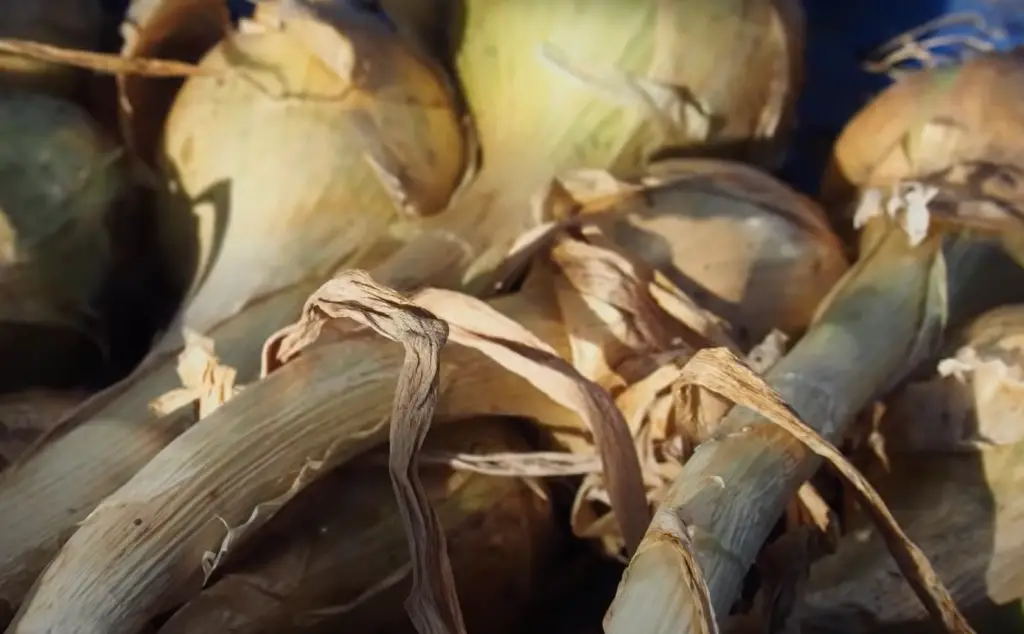
In addition, harvesting too early or too late can also affect the taste of your onions. If you pick them before their maturity, they’ll be overly tender and have a bitter flavour.
On the other hand, if you wait too long to harvest, then your onions will be tough and fibrous – not exactly ideal for adding to salads! [1]
When to Harvest Onions
Now that you know which varieties to choose and the general time frame for harvesting, let’s take a look at some specific tips to ensure you get your onions at just the right moment.
Pull back a few of the outer layers and inspect the bulb of each onion for size and colour. If they appear ready, then go ahead and carefully pull them out of the ground.As a general rule, you should aim to harvest onions when their neck has started to wither (this occurs around mid-summer).
To make sure your onions are good and cured before storage, try leaving them outdoors in direct sunlight for a few days. This will help toughen up the skin and make for long-lasting onions that can be stored in a cool, dry place.
How to Harvest Onions
Let’s look at the best way to harvest your onions. When it comes time to pick, be sure to handle them with care in order to avoid bruising or damage. If you’re harvesting manually, use a garden fork or trowel and loosen the soil around the bulbs before carefully lifting them out of the ground.
If you’re using a harvester, be sure to check the machine’s instructions carefully before use. Some harvesters can cause bruising or damage if used incorrectly – so make sure you take your time and double-check everything before beginning.
Once harvested, rinse off any excess dirt and set aside for curing. Make sure to inspect each onion individually for signs of disease or rot (such as black spots or softness) and discard any that don’t meet your standards.
Drying and Storing Onion Bulbs
Once your onions are all cured and ready to go, it’s time for the final step: drying and storing. To do this, simply hang them in a cool, dry place with plenty of air circulation (such as an attic or garage). This will help them last longer while also preventing mould from forming.
You can also use a dehydrator for extra protection against moisture – and if you do, make sure to follow the manufacturer’s instructions carefully. After a few days in the drying area, your onions should be ready for storage.

Simply wrap them up individually in newspaper or paper towels and store them in an airtight container for up to several months.
Curing Onions
Curing your onions properly is essential if you want to enjoy the best-tasting produce all year long.
You should cure your onions for at least two weeks before storing them. This will help them develop a sweeter flavour and preserve their freshness for longer.
Be sure to check on them every few days during this time – if the skin starts to wrinkle or dry out too much, then mist them lightly with water. [2]
How to Store Onions
Now that your onions are properly cured and dried, it’s time to store them for the long haul. The best way to do this is by wrapping them individually in newspaper or paper towels before placing them in an airtight container.
Be sure to label each container with the date of harvest – this will help you keep track of which onions have been stored for longer periods of time.
This will help them maintain their quality for months (or even up to a year).FAQ
How do you know when an onion is ready to pick?
Generally speaking, a successful harvest will take place when the onion tops start to turn yellow and flop over. This usually occurs around mid-summer – but keep in mind that the exact timing depends on location and soil conditions.
The best way to check if your onions are ready is to observe them closely – literally. Pull back a few of the outer layers and inspect the bulb of each onion for size and colour.
What is the best way to harvest onions?
When it comes time to pick, be sure to handle them with care in order to avoid bruising or damage.
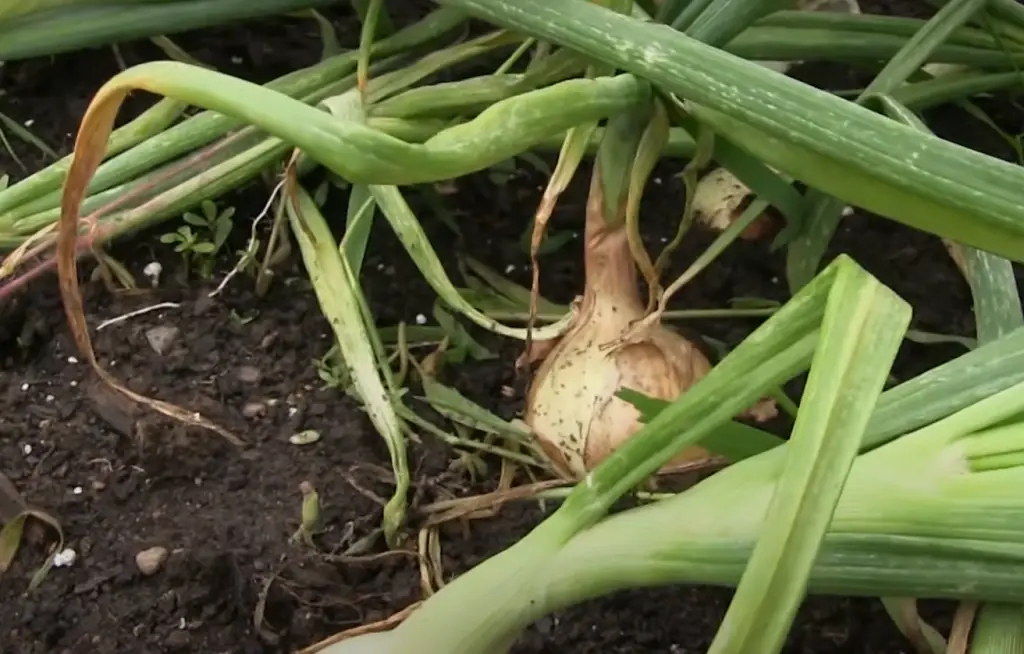
If you’re harvesting manually, use a garden fork or trowel and loosen the soil around the bulbs before carefully lifting them out of the ground. If you’re using a harvester, be sure to check the machine’s instructions carefully before use.
How do I store onions for longer periods of time?
The best way to store onions is by wrapping them individually in newspaper or paper towels before placing them in an airtight container. Be sure to label each container with the date of harvest – this will help you keep track of which onions have been stored for longer periods of time.
For added longevity, try storing your onions in the refrigerator or freezer – just be sure to check the temperature settings before use. This will help them maintain their quality for months (or even up to a year).
Do you harvest onions before or after they flower?
Onions are ready to harvest before they flower. The best way to check if your onions are ready is to observe them closely – literally. Pull back a few of the outer layers and inspect the bulb of each onion for size and colour. If they appear ready, then go ahead and carefully pull them out of the ground.
Once harvested, rinse off any excess dirt and set aside for curing. Make sure to inspect each onion individually for signs of disease or rot (such as black spots or softness) and discard any that don’t meet your standards.
Can you use onions immediately after harvesting?
Yes, you can use onions immediately after harvesting. While they may not be as sweet and flavourful as their cured counterparts, fresh onion bulbs can still provide your meals with a subtle, juicy crunch.
However, for the best-tasting onions, it’s recommended that you cure them properly before storing or consuming them (see the above section on curing).
How long do onions need to grow before you pull them?
Onions usually take between 90 and 150 days to reach maturity. To check for ripeness, look for yellowing foliage and/or a softening of the stems near the soil surface. If you’re still not sure, then pull back a few of the outer layers and inspect the bulb – if it appears ready, then go ahead and carefully pull them out of the ground.
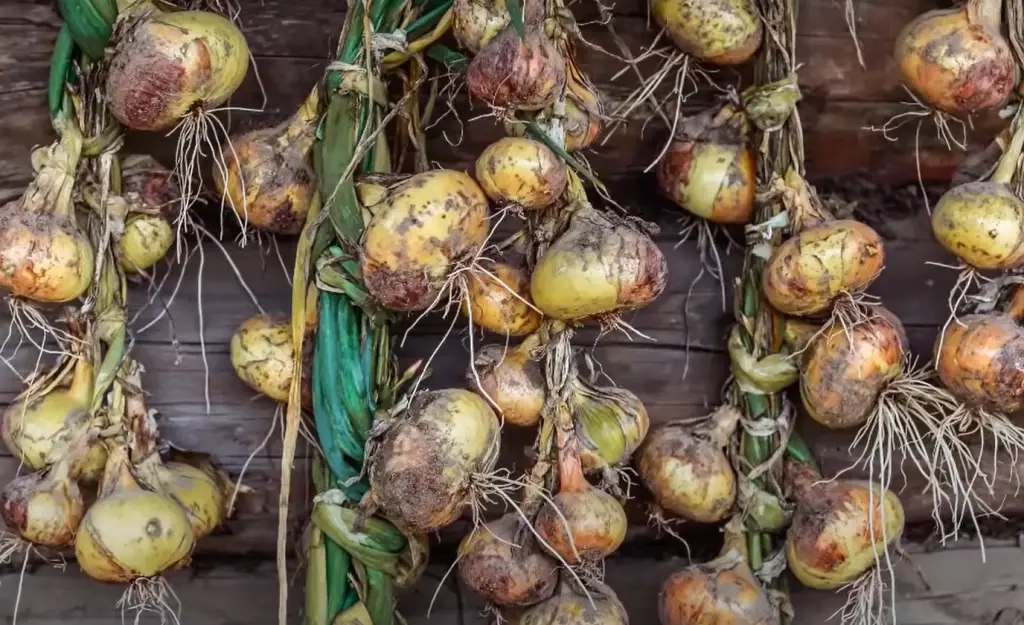
Be sure to handle them with care in order to avoid bruising or damage. If you’re harvesting manually, use a garden fork or trowel and loosen the soil around the bulbs before carefully lifting them out of the ground. If you’re using a harvester, be sure to check the machine’s instructions carefully before use.
Why do you dry onions after harvesting?
Drying onions helps them last longer while also preventing mould from forming. To do this, simply hang them in a cool, dry place with plenty of air circulation (such as an attic or garage). This will help keep the moisture levels down and prevent excessive spoilage.
You can also use a dehydrator for extra protection against moisture – and if you do, make sure to follow the manufacturer’s instructions carefully. After a few days in the drying area, your onions should be ready for storage.
Simply wrap them up individually in newspaper or paper towels and store them in an airtight container for up to several months.
This will help ensure that you have access to fresh onions throughout the year without having to worry about spoilage or mould growth.
What is the best way to store onions?
The best way to store onions is by wrapping them individually in newspaper or paper towels before placing them in an airtight container. Be sure to label each container with the date of harvest – this will help you keep track of which onions have been stored for longer periods of time.
For added longevity, try storing your onions in the refrigerator or freezer – just be sure to check the temperature settings before use.
This will help them maintain their quality for months (or even up to a year). Additionally, it’s important to keep onions away from other strong-smelling foods – like garlic and potatoes – as this can cause them to spoil more quickly.
What are the health benefits of onions?
Onions are a great source of vitamins and minerals, including vitamin C, B6, potassium and manganese. They also contain antioxidants that help protect against cell damage and even reduce inflammation.
On top of this, onions have been linked to lower cholesterol levels and improved digestion – making them an all-around beneficial food for your health. So, make sure to add plenty of onions to your meals – your body will thank you!
Are harvested onions edible right away?
Yes, harvested onions are edible right away. While they may not be as sweet and flavourful as their cured counterparts, fresh onion bulbs can still provide your meals with a subtle, juicy crunch. However, for the best-tasting onions, it’s recommended that you cure them properly before storing or consuming them. Curing helps preserve the flavour and texture of onions and will help keep them fresh for longer periods of time. To do this, simply hang them in a cool, dry place with plenty of air circulation (such as an attic or garage).
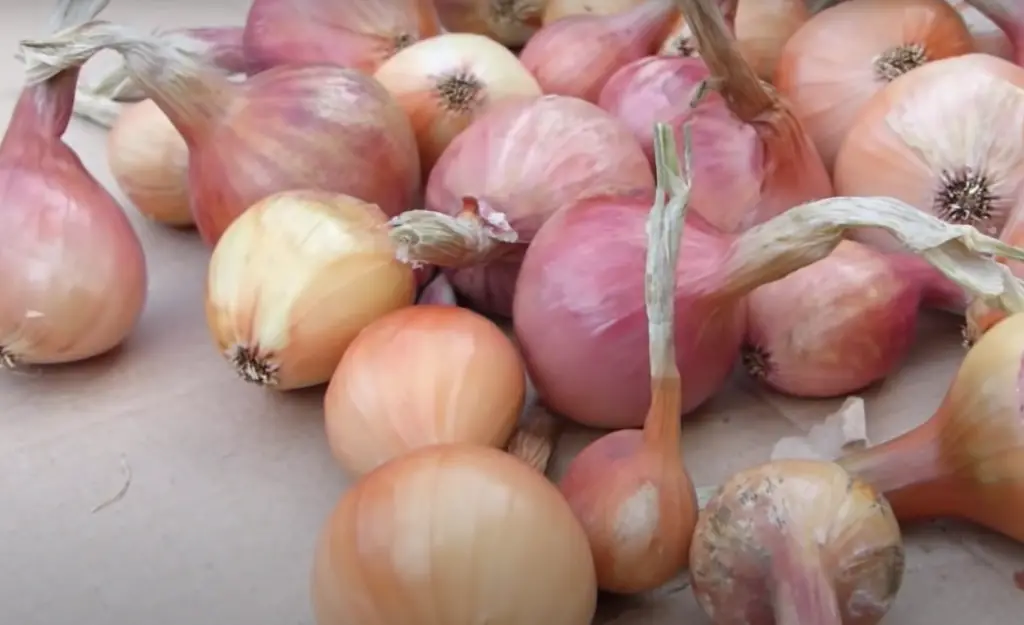
This will help keep the moisture levels down and prevent excessive spoilage. You can also use a dehydrator for extra protection against moisture – and if you do, make sure to follow the manufacturer’s instructions carefully.
How long can you store onions?
Onions can be stored for up to several months, depending on how they are cared for. The best way to store onions is by wrapping them individually in newspaper or paper towels before placing them in an airtight container.
Be sure to label each container with the date of harvest – this will help you keep track of which onions have been stored for longer periods of time.
For added longevity, try storing your onions in the refrigerator or freezer – just be sure to check the temperature settings before use. This will help them maintain their quality for months (or even up to a year).
How do you know when onions have gone bad?
One of the best ways to tell if an onion has gone bad is by inspecting it closely. Look for signs of mould, rot or other discoloration of the outer layers and bulb. If these are present, then the onion should be discarded immediately.
Additionally, pay attention to any strong odours – this could indicate that the onion is no longer fresh. If you notice any of these signs, it’s best to toss the onion in order to avoid food-borne illness or other health risks.
Why is it important to harvest onions on time?
It’s important to harvest onions on time in order to maximise their flavour, texture and nutritional benefits. Onions are most nutritious when they’re freshly harvested – once stored, their nutritional content starts to decline. Additionally, harvesting them too early can lead to small bulbs that may be difficult to peel or store properly.
Finally, harvesting them too late can result in dry, tough onions that are difficult to cook with and may lack the sweetness of freshly harvested ones. By following the instructions above, you can ensure that you harvest onions at the perfect time for optimal taste and nutrition.
Why do you need to be careful when harvesting onions?
It’s important to be careful when harvesting onions as they can easily become bruised or damaged if handled roughly. When manually harvesting, use a garden fork or trowel and loosen the soil around the bulbs before carefully lifting them out of the ground.
If using a harvester, be sure to double-check the settings and only use the recommended speed to avoid accidentally damaging the onions.
How can you tell when onions are ripe and ready to be harvested?
There are a few indicators that will help you determine when onions are ripe and ready to be harvested.
Firstly, look for yellowing or browning of the leaves – this is usually a sign that the onion has stopped growing and is ready to be picked. Secondly, the neck of the onion should be fairly dry and shrivelled; this is also a sign of maturity.
Finally, the bulbs should be firm when squeezed – if they feel soft or mushy, then it’s best to wait until the onions have fully matured before harvesting them.
Does harvesting onions at the wrong time affect their flavour?
Yes, harvesting onions at the wrong time can affect their flavour as well as their texture. Onions picked too early will be small and lacking in sweetness – while those harvested too late will be dry and tough with a pungent taste. It’s important to harvest them at the right time in order to maximise their flavour, texture and nutritional benefits.
By following the instructions above, you can ensure that you harvest onions at the perfect time for optimal taste and nutrition.
Do onions need to be cured before storing?
Yes, onions should be cured before storing in order to preserve their flavour and texture. Curing helps remove excess moisture and prevents spoilage – making them last much longer when stored correctly. To do this, simply hang them in a cool, dry place with plenty of air circulation (such as an attic or garage).
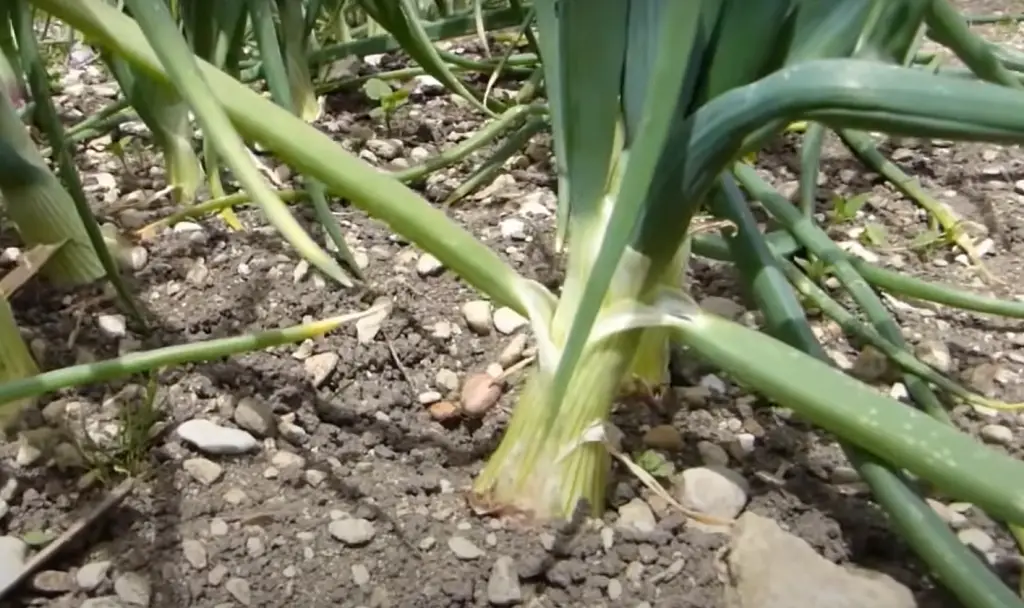
This will help keep the moisture levels down and prevent excessive spoilage. You can also use a dehydrator for extra protection against moisture – and if you do, make sure to follow the manufacturer’s instructions carefully.
Does harvesting onions require any special tools?
No, harvesting onions does not require any special tools or machinery. Most gardeners simply use a garden fork or trowel to manually lift the bulbs out of the ground.
However, if you’re looking for an easier way to harvest your onions, there are mechanical harvesters available that can help speed up the process. Just be sure to double-check the settings before use and only use those recommended by the manufacturer.
Do onions require any special care after harvesting?
Yes, onions should be handled with extra care after harvesting in order to maintain their quality. After removing them from the ground, brush off any excess dirt and debris before laying them out in a single layer on a clean surface. This will help ensure that they are not damaged or bruised during transit.
Additionally, it’s important to store them in an airtight container or bag with plenty of ventilation. This will help keep the moisture levels down and prevent excessive spoilage.
Finally, be sure to label each container with the date of harvest – this will help you keep track of which onions have been stored for longer periods of time.
Does it matter how you store onions once they are harvested?
Yes, it does matter how you store onions after harvesting as this will affect their longevity and quality. The best way to store them is in a cool, dark place with plenty of ventilation – such as an attic or garage.
If temperature fluctuations are expected, try wrapping each onion individually in newspaper or paper towels before placing it in a container or bag. This will help keep the moisture levels down and prevent excessive spoilage.
Useful Video: Harvesting Onions & How To Tell When They Are Ready To Be Harvested
Conclusion
Harvesting onions is a great way to enjoy fresh vegetables all year round. To ensure success, make sure to wait until the tops of the onions start to die down or fall over and begin to turn brown before harvesting. You should also pay attention to the size of the onion, as it needs to reach adequate maturity before being harvested.
As a reward for your patience, you’ll enjoy sweeter tasting onions that will last longer in storage. Remember that if you harvest them too early they may be tough and bitter when eaten raw, and won’t store as long as those allowed to fully mature in the garden. Knowing when to harvest your onions is an important component for successfully growing them in the garden. Be sure to utilise these tips for the best results from harvesting your onions!
References:
- https://www.gardeningknowhow.com/edible/vegetables/onion/harvesting-onions.htm#:~:text=Bulb%20onion%20harvest%20time%20can,planting%2C%20depending%20on%20the%20cultivar.
- https://www.bhg.com/gardening/vegetable/vegetables/when-to-harvest-onions/










Leave a Reply
View Comments